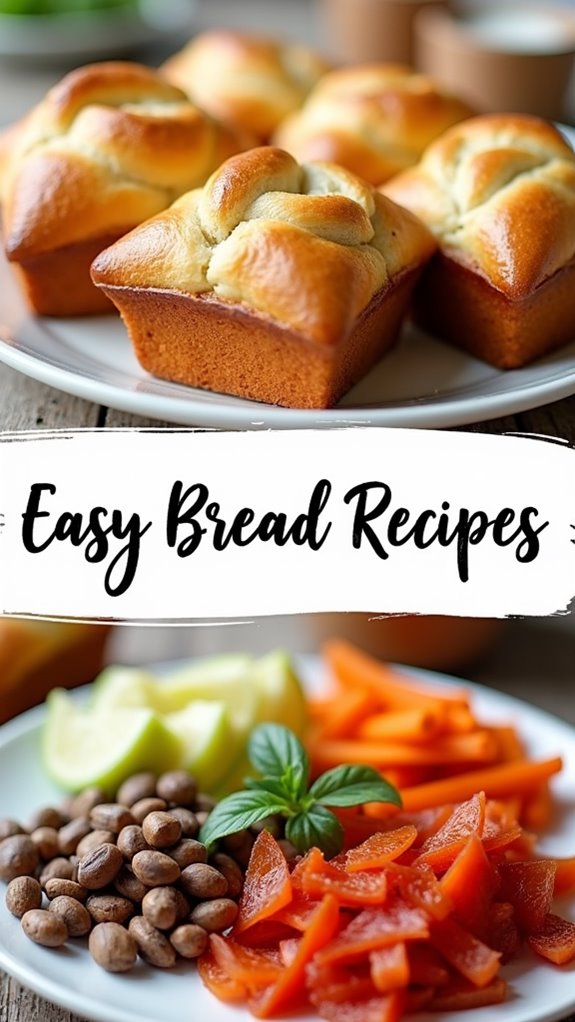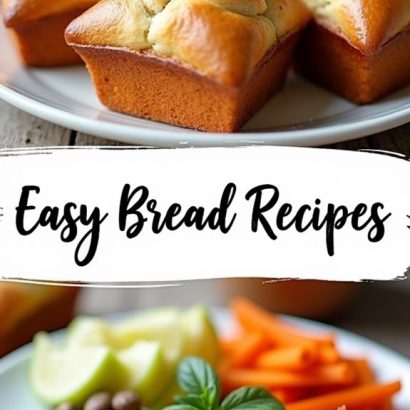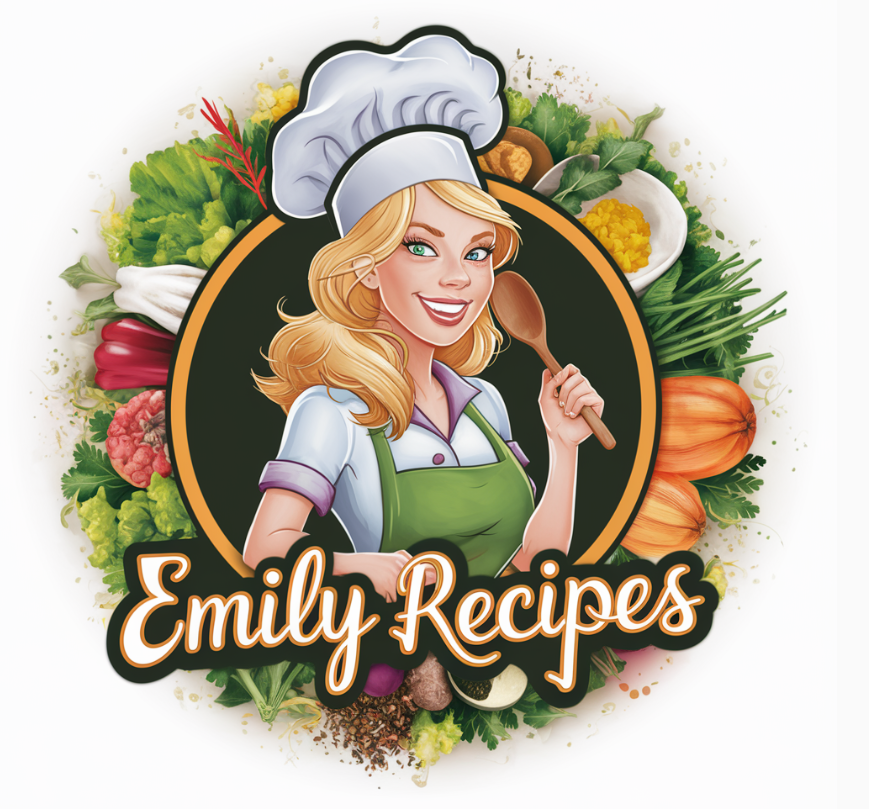Easy Bread Recipes
If you’ve never baked bread before, easy bread recipes are a great way to start. They use simple ingredients like flour, water, and yeast, which you probably already have at home. These recipes require minimal time and effort, fitting perfectly into a busy lifestyle. Plus, the smell of baking bread can make your kitchen feel warm and inviting. Curious about how to whip up your first loaf? Let’s explore the steps together.
Why You’ll Love This Recipe
When you decide to bake bread at home, you’ll quickly discover how rewarding it can be. This recipe is simple, making it perfect for both beginners and experienced bakers.
You’ll love how the aroma fills your kitchen, creating a cozy atmosphere. Plus, it requires just a few common ingredients, so you won’t need to run to the store.
As you knead the dough, you’ll feel a sense of accomplishment, knowing you’re creating something delicious from scratch. Baking bread also allows for creativity; you can add herbs, spices, or even cheese to customize flavors.
Finally, the satisfaction of slicing into a warm loaf, and enjoying it fresh, is a joy that store-bought bread simply can’t match. You’ll definitely appreciate the process and the result!
History
Baking bread has a long and fascinating history that stretches back thousands of years. It all began in ancient civilizations, where people discovered that mixing flour and water created a dough that could be transformed through baking.
The Egyptians are often credited with inventing leavened bread, using wild yeast to make their bread rise. As trade routes expanded, different cultures shared their bread-making techniques, leading to a variety of styles across the globe.
In medieval Europe, bread was a staple food, with different grains used based on local availability. Fast forward to today, and bread remains a cornerstone of diets worldwide, with countless recipes and methods to explore.
Understanding this history can deepen your appreciation for the simple yet profound act of baking bread.
Recipe

Ingredients:
– 3 cups all-purpose flour
– 1 packet (2 ¼ teaspoons) active dry yeast
– 1 tablespoon sugar
– 1 teaspoon salt
– 1 cup warm water (about 110°F)
– 2 tablespoons olive oil
Instructions:
1. In a large mixing bowl, combine the warm water, sugar, and yeast. Allow the mixture to sit for about 5-10 minutes until it becomes frothy, indicating that the yeast is active.
- Add the olive oil and salt to the yeast mixture, then gradually stir in the flour, one cup at a time, until a dough forms.
- Turn the dough onto a floured surface and knead it for about 5-7 minutes until it’s smooth and elastic. If the dough is too sticky, sprinkle a little more flour as needed.
- Place the kneaded dough into a lightly greased bowl, cover it with a clean cloth, and let it rise in a warm place for about 1 hour or until it has doubled in size.
- After the dough has risen, punch it down gently to release the air. Shape it into a loaf and place it into a greased 9×5-inch loaf pan.
- Cover the loaf pan with a cloth and let it rise again for about 30 minutes until it puffs up.
- Preheat your oven to 375°F (190°C). Bake the bread for 25-30 minutes, or until the top is golden brown and the bread sounds hollow when tapped.
- Remove the bread from the oven and let it cool in the pan for 10 minutes before transferring it to a wire rack to cool completely.
Baking bread can seem intimidating, but with this easy recipe, you’ll find that it’s quite straightforward.
One important tip to keep in mind is to verify your yeast is fresh and active; expired yeast can lead to a flat loaf.
Also, feel free to experiment with different types of flour, such as whole wheat or bread flour, to create variations in flavor and texture.
Happy baking!
Final Thoughts
Making bread at home can be a rewarding experience, especially when you see the final product rise beautifully in the oven.
You’ll find that baking bread isn’t just about following recipes; it’s also about experimenting and discovering what works best for you. Start with simple recipes to build your confidence, and don’t be afraid to make adjustments based on your taste.
Remember, practice makes perfect, and each loaf will teach you something new. Pay attention to your ingredients and techniques, as they can greatly impact your results.
Most importantly, enjoy the process. Whether you’re baking for yourself or sharing with others, homemade bread brings a sense of accomplishment.
FAQ
When you’re new to baking bread, it’s natural to have questions about the process. One common question is, “Why did my bread not rise?” This can happen if your yeast is expired or the water temperature was too hot or cold.
Another frequent concern is, “How do I know when my bread is done?” The best way is to tap the bottom; if it sounds hollow, it’s ready.
You might also wonder about storage. To keep your bread fresh, store it in a cool, dry place, preferably in a bread box or paper bag.
Finally, don’t hesitate to experiment with different ingredients and flavors; baking is about creativity and practice. Keep asking questions, and enjoy your bread-making journey!

EASY BREAD RECIPES
Ingredients
- Ingredients:
- - 3 cups all-purpose flour
- - 1 packet 2 ¼ teaspoons active dry yeast
- - 1 tablespoon sugar
- - 1 teaspoon salt
- - 1 cup warm water about 110°F
- - 2 tablespoons olive oil
Instructions
- Instructions:
- In a large mixing bowl, combine the warm water, sugar, and yeast. Allow the mixture to sit for about 5-10 minutes until it becomes frothy, indicating that the yeast is active.
- Add the olive oil and salt to the yeast mixture, then gradually stir in the flour, one cup at a time, until a dough forms.
- Turn the dough onto a floured surface and knead it for about 5-7 minutes until it's smooth and elastic. If the dough is too sticky, sprinkle a little more flour as needed.
- Place the kneaded dough into a lightly greased bowl, cover it with a clean cloth, and let it rise in a warm place for about 1 hour or until it has doubled in size.
- After the dough has risen, punch it down gently to release the air. Shape it into a loaf and place it into a greased 9x5-inch loaf pan.
- Cover the loaf pan with a cloth and let it rise again for about 30 minutes until it puffs up.
- Preheat your oven to 375°F (190°C). Bake the bread for 25-30 minutes, or until the top is golden brown and the bread sounds hollow when tapped.
- Remove the bread from the oven and let it cool in the pan for 10 minutes before transferring it to a wire rack to cool completely.
- Baking bread can seem intimidating, but with this easy recipe, you'll find that it's quite straightforward.
- One important tip to keep in mind is to verify your yeast is fresh and active; expired yeast can lead to a flat loaf.
- Also, feel free to experiment with different types of flour, such as whole wheat or bread flour, to create variations in flavor and texture.
